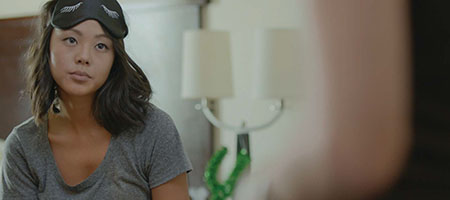Tackling the Art of Key Lighting
Key lighting seems like the simplest idea when setting up a scene with light as it’s the main light on the subject. As a cinematographer, you tend to think about it first when going into a scene. When cinematographers start out, they often point lights directly at their subjects. Usually, they do not think about diffusion or cutting; they are just trying to get the exposure they want.
Key lighting a face is truly an art, and there are many ways to do it. It is not just about the source you use, but the quality of it, its intensity, direction and color. I wanted to address the two ways I typically key because I very rarely point lights at faces directly. These examples have been useful in many different situations. When you point a unit directly at someone, it’s probably going to be hard in quality and not as flattering on the face. There are also so many skin tones to consider.
BOUNCE LIGHTING
More than just the key can be set up using bounce lighting. Bounce lighting is simply hitting the source into another surface, and lighting with the return that bounces off of that surface. For example, a way to fill a room is to bounce a unit into the ceiling to create ambient light.
Bounce lighting as a key is a great way to spread the source, soften it and maintain a more natural look. A specific use for bounce keying is creating a television or movie screen effect. Bouncing is great for this because a movie theater screen is usually large, so spreading the light by bouncing helps create a larger, but soft, key light. If the screen the person was watching was very small and close to them, then I might consider containing the light a little more and not spreading it by bouncing.

Screengrab from Jilted with bounce lighting
Another great use of bounce lighting is the need to key someone who does not actually have a source on a particular side of a room to light them. In my very first feature, “Jilted,” I had a character in a small hotel room facing away from the window. Naturally, she was pretty dark. So to bring her exposure up I bounced a Leko with half CTB on it into a board to create a natural return on her from the window.
Bounce lighting is all about direction, so really take in your location and blocking to help you determine where to bounce from and the direction of the bounce. Sometimes hiding the unit that you are bouncing can be a challenge.
BOOK LIGHTING
Frequently, I find myself with a need to be soft with my key. Taking bounce light a step further involves shooting that beam bouncing off a surface through diffusion. A “book light” is a rig that contains a unit between a bounce surface—such as an ultra bounce or board—and a rag or sheet of diffusion, like a grid or some type of silk.

Anette Haellmigk in an interview for Women of Light lit with a book light
This makes for a very soft light and comes in handy quite a lot. I did a whole feature documentary with book lights for keys on every subject. An example is Anette Haellmigk, director of photography on “Game of Thrones,” lit with a 5K tungsten fresnel bouncing off an ultra bounce rag, back through a silk.
Book lights are the ultimate soft light, and depending on the material you use as a bounce and the level of diffusion you choose, you can have control over just how soft it is.
I have talked about filming subjects right up against windows before, and book lighting is the trick to keying someone in this situation. A book light gives you the softness you need to make the key look natural enough against a window. The hard part is making a book light bright enough—you are bouncing it and then diffusing it, so you need to go into this with a stronger unit for fighting a window if you want to maintain exposure outside.
Ultimately, the key light is determined by the space. Unless you are going with something completely unmotivated, you are probably going to draw upon what is available in the space and what is happening in the scene to decide on the placement and characteristics of your key.
Like always, the story is always king, even in determining how to treat a scene with light.
Julia Swain is a cinematographer based in California, whose narrative films include “Killing Animals,” “Jilted” and “Cassidy Red.” She continues to shoot on a variety of formats, seeking to create compelling visuals for every story and brand. She can be contacted through TV Technology.
Get the TV Tech Newsletter
The professional video industry's #1 source for news, trends and product and tech information. Sign up below.
